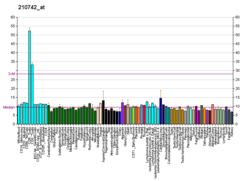Dual specificity protein phosphatase CDC14A is an enzyme that in humans is encoded by the CDC14A gene.[5][6][7]
The protein encoded by this gene is a member of the dual specificity protein tyrosine phosphatase family. This protein is highly similar to Saccharomyces cerevisiae Cdc14, a protein tyrosine phosphatase involved in the exit of cell mitosis and initiation of DNA replication, which suggests the role in cell cycle control. This protein has been shown to interact with and dephosphorylates tumor suppressor protein p53, and is thought to regulate the function of p53. Alternative splice of this gene results in 3 transcript variants encoding distinct isoforms.[7]
Interactions
CDC14A has been shown to interact with P53, de-phosphorylate p53 at Serine 315 and thereby stabilize p53.[8] S315-phosphorylated p53, in contrast to other p53 phosphorylation, was shown to facilitate p53 degradation.[9]
References
- ^ a b c GRCh38: Ensembl release 89: ENSG00000079335 – Ensembl, May 2017
- ^ a b c GRCm38: Ensembl release 89: ENSMUSG00000033502 – Ensembl, May 2017
- ^ "Human PubMed Reference:". National Center for Biotechnology Information, U.S. National Library of Medicine.
- ^ "Mouse PubMed Reference:". National Center for Biotechnology Information, U.S. National Library of Medicine.
- ^ Li L, Ernsting BR, Wishart MJ, Lohse DL, Dixon JE (December 1997). "A family of putative tumor suppressors is structurally and functionally conserved in humans and yeast". J Biol Chem. 272 (47): 29403–6. doi:10.1074/jbc.272.47.29403. PMID 9367992.
- ^ Wong AK, Chen Y, Lian L, Ha PC, Petersen K, Laity K, Carillo A, Emerson M, Heichman K, Gupte J, Tavtigian SV, Teng DH (September 1999). "Genomic structure, chromosomal location, and mutation analysis of the human CDC14A gene". Genomics. 59 (2): 248–51. doi:10.1006/geno.1999.5863. PMID 10409437.
- ^ a b "Entrez Gene: CDC14A CDC14 cell division cycle 14 homolog A (S. cerevisiae)".
- ^ Li, L; Ljungman M; Dixon J E (January 2000). "The human Cdc14 phosphatases interact with and dephosphorylate the tumor suppressor protein p53 at Serine 315". J. Biol. Chem. 275 (4): 2410–4. doi:10.1074/jbc.275.4.2410. ISSN 0021-9258. PMID 10644693.
- ^ Li, Y; Cui K; Zhang Q; Li X; Lin X; Tang Y; Prochownik E; Li Y (July 2021). "FBXL6 degrades phosphorylated p53 to promote tumor growth". Cell Death Differ. 28 (7): 2112–2125. doi:10.1038/s41418-021-00739-6. ISSN 1350-9047. PMC 8257708. PMID 33568778.
External links
- Human CDC14A genome location and CDC14A gene details page in the UCSC Genome Browser.
Further reading
- Li L, Ljungman M, Dixon JE (2000). "The human Cdc14 phosphatases interact with and dephosphorylate the tumor suppressor protein p53". J. Biol. Chem. 275 (4): 2410–4. doi:10.1074/jbc.275.4.2410. PMID 10644693.
- Bembenek J, Yu H (2002). "Regulation of the anaphase-promoting complex by the dual specificity phosphatase human Cdc14a". J. Biol. Chem. 276 (51): 48237–42. doi:10.1074/jbc.M108126200. PMID 11598127.
- Mailand N, Lukas C, Kaiser BK, et al. (2002). "Deregulated human Cdc14A phosphatase disrupts centrosome separation and chromosome segregation". Nat. Cell Biol. 4 (4): 317–22. doi:10.1038/ncb777. PMID 11901424. S2CID 28955777.
- Kaiser BK, Zimmerman ZA, Charbonneau H, Jackson PK (2003). "Disruption of centrosome structure, chromosome segregation, and cytokinesis by misexpression of human Cdc14A phosphatase". Mol. Biol. Cell. 13 (7): 2289–300. doi:10.1091/mbc.01-11-0535. PMC 117313. PMID 12134069.
- Strausberg RL, Feingold EA, Grouse LH, et al. (2003). "Generation and initial analysis of more than 15,000 full-length human and mouse cDNA sequences". Proc. Natl. Acad. Sci. U.S.A. 99 (26): 16899–903. Bibcode:2002PNAS...9916899M. doi:10.1073/pnas.242603899. PMC 139241. PMID 12477932.
- Gruneberg U, Neef R, Honda R, et al. (2004). "Relocation of Aurora B from centromeres to the central spindle at the metaphase to anaphase transition requires MKlp2". J. Cell Biol. 166 (2): 167–72. doi:10.1083/jcb.200403084. PMC 2172317. PMID 15263015.
- Gerhard DS, Wagner L, Feingold EA, et al. (2004). "The status, quality, and expansion of the NIH full-length cDNA project: the Mammalian Gene Collection (MGC)". Genome Res. 14 (10B): 2121–7. doi:10.1101/gr.2596504. PMC 528928. PMID 15489334.
- Vázquez-Novelle MD, Esteban V, Bueno A, Sacristán MP (2005). "Functional homology among human and fission yeast Cdc14 phosphatases". J. Biol. Chem. 280 (32): 29144–50. doi:10.1074/jbc.M413328200. hdl:10366/157107. PMID 15911625.
- Zhao H, Wang Q, Zhang H, et al. (2006). "UXT is a novel centrosomal protein essential for cell viability". Mol. Biol. Cell. 16 (12): 5857–65. doi:10.1091/mbc.E05-08-0705. PMC 1289427. PMID 16221885.
- Kimura K, Wakamatsu A, Suzuki Y, et al. (2006). "Diversification of transcriptional modulation: large-scale identification and characterization of putative alternative promoters of human genes". Genome Res. 16 (1): 55–65. doi:10.1101/gr.4039406. PMC 1356129. PMID 16344560.
- Sanchez M, Galy B, Dandekar T, et al. (2006). "Iron regulation and the cell cycle: identification of an iron-responsive element in the 3'-untranslated region of human cell division cycle 14A mRNA by a refined microarray-based screening strategy". J. Biol. Chem. 281 (32): 22865–74. doi:10.1074/jbc.M603876200. PMID 16760464.
- Paulsen MT, Starks AM, Derheimer FA, et al. (2006). "The p53-targeting human phosphatase hCdc14A interacts with the Cdk1/cyclin B complex and is differentially expressed in human cancers". Mol. Cancer. 5: 25. doi:10.1186/1476-4598-5-25. PMC 1524803. PMID 16784539.
- Esteban V, Vázquez-Novelle MD, Calvo E, et al. (2007). "Human Cdc14A reverses CDK1 phosphorylation of Cdc25A on serines 115 and 320". Cell Cycle. 5 (24): 2894–8. doi:10.4161/cc.5.24.3566. hdl:10261/60508. PMID 17172867.
- Lanzetti L, Margaria V, Melander F, et al. (2007). "Regulation of the Rab5 GTPase-activating protein RN-tre by the dual specificity phosphatase Cdc14A in human cells". J. Biol. Chem. 282 (20): 15258–70. doi:10.1074/jbc.M700914200. PMID 17371873.
- Yuan K, Hu H, Guo Z, et al. (2007). "Phospho-regulation of HsCdc14A By Polo-like kinase 1 is essential for mitotic progression". J. Biol. Chem. 282 (37): 27414–23. doi:10.1074/jbc.M703555200. PMID 17623655.






